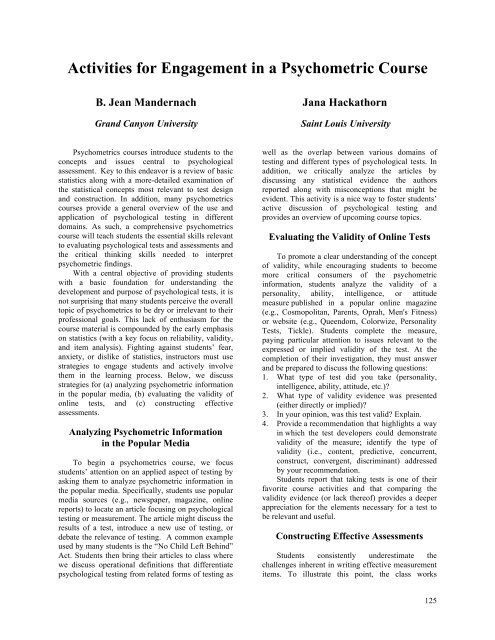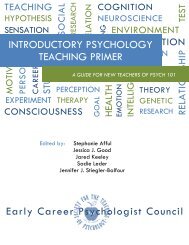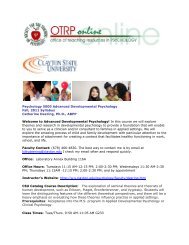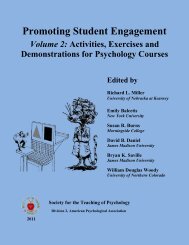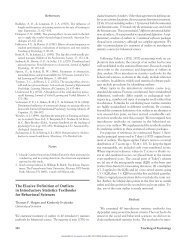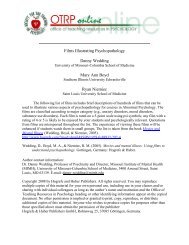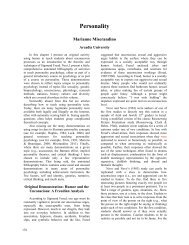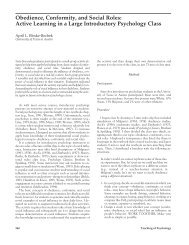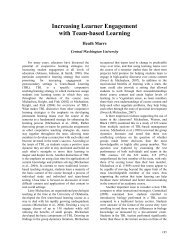Activities for Engagement in a Psychometric Course - Society for the ...
Activities for Engagement in a Psychometric Course - Society for the ...
Activities for Engagement in a Psychometric Course - Society for the ...
Create successful ePaper yourself
Turn your PDF publications into a flip-book with our unique Google optimized e-Paper software.
<strong>Activities</strong> <strong>for</strong> <strong>Engagement</strong> <strong>in</strong> a <strong>Psychometric</strong> <strong>Course</strong><br />
B. Jean Mandernach Jana Hackathorn<br />
Grand Canyon University Sa<strong>in</strong>t Louis University<br />
<strong>Psychometric</strong>s courses <strong>in</strong>troduce students to <strong>the</strong><br />
concepts and issues central to psychological<br />
assessment. Key to this endeavor is a review of basic<br />
statistics along with a more-detailed exam<strong>in</strong>ation of<br />
<strong>the</strong> statistical concepts most relevant to test design<br />
and construction. In addition, many psychometrics<br />
courses provide a general overview of <strong>the</strong> use and<br />
application of psychological test<strong>in</strong>g <strong>in</strong> different<br />
doma<strong>in</strong>s. As such, a comprehensive psychometrics<br />
course will teach students <strong>the</strong> essential skills relevant<br />
to evaluat<strong>in</strong>g psychological tests and assessments and<br />
<strong>the</strong> critical th<strong>in</strong>k<strong>in</strong>g skills needed to <strong>in</strong>terpret<br />
psychometric f<strong>in</strong>d<strong>in</strong>gs.<br />
With a central objective of provid<strong>in</strong>g students<br />
with a basic foundation <strong>for</strong> understand<strong>in</strong>g <strong>the</strong><br />
development and purpose of psychological tests, it is<br />
not surpris<strong>in</strong>g that many students perceive <strong>the</strong> overall<br />
topic of psychometrics to be dry or irrelevant to <strong>the</strong>ir<br />
professional goals. This lack of enthusiasm <strong>for</strong> <strong>the</strong><br />
course material is compounded by <strong>the</strong> early emphasis<br />
on statistics (with a key focus on reliability, validity,<br />
and item analysis). Fight<strong>in</strong>g aga<strong>in</strong>st students’ fear,<br />
anxiety, or dislike of statistics, <strong>in</strong>structors must use<br />
strategies to engage students and actively <strong>in</strong>volve<br />
<strong>the</strong>m <strong>in</strong> <strong>the</strong> learn<strong>in</strong>g process. Below, we discuss<br />
strategies <strong>for</strong> (a) analyz<strong>in</strong>g psychometric <strong>in</strong><strong>for</strong>mation<br />
<strong>in</strong> <strong>the</strong> popular media, (b) evaluat<strong>in</strong>g <strong>the</strong> validity of<br />
onl<strong>in</strong>e tests, and (c) construct<strong>in</strong>g effective<br />
assessments.<br />
Analyz<strong>in</strong>g <strong>Psychometric</strong> In<strong>for</strong>mation<br />
<strong>in</strong> <strong>the</strong> Popular Media<br />
To beg<strong>in</strong> a psychometrics course, we focus<br />
students’ attention on an applied aspect of test<strong>in</strong>g by<br />
ask<strong>in</strong>g <strong>the</strong>m to analyze psychometric <strong>in</strong><strong>for</strong>mation <strong>in</strong><br />
<strong>the</strong> popular media. Specifically, students use popular<br />
media sources (e.g., newspaper, magaz<strong>in</strong>e, onl<strong>in</strong>e<br />
reports) to locate an article focus<strong>in</strong>g on psychological<br />
test<strong>in</strong>g or measurement. The article might discuss <strong>the</strong><br />
results of a test, <strong>in</strong>troduce a new use of test<strong>in</strong>g, or<br />
debate <strong>the</strong> relevance of test<strong>in</strong>g. A common example<br />
used by many students is <strong>the</strong> “No Child Left Beh<strong>in</strong>d”<br />
Act. Students <strong>the</strong>n br<strong>in</strong>g <strong>the</strong>ir articles to class where<br />
we discuss operational def<strong>in</strong>itions that differentiate<br />
psychological test<strong>in</strong>g from related <strong>for</strong>ms of test<strong>in</strong>g as<br />
well as <strong>the</strong> overlap between various doma<strong>in</strong>s of<br />
test<strong>in</strong>g and different types of psychological tests. In<br />
addition, we critically analyze <strong>the</strong> articles by<br />
discuss<strong>in</strong>g any statistical evidence <strong>the</strong> authors<br />
reported along with misconceptions that might be<br />
evident. This activity is a nice way to foster students’<br />
active discussion of psychological test<strong>in</strong>g and<br />
provides an overview of upcom<strong>in</strong>g course topics.<br />
Evaluat<strong>in</strong>g <strong>the</strong> Validity of Onl<strong>in</strong>e Tests<br />
To promote a clear understand<strong>in</strong>g of <strong>the</strong> concept<br />
of validity, while encourag<strong>in</strong>g students to become<br />
more critical consumers of <strong>the</strong> psychometric<br />
<strong>in</strong><strong>for</strong>mation, students analyze <strong>the</strong> validity of a<br />
personality, ability, <strong>in</strong>telligence, or attitude<br />
measure published <strong>in</strong> a popular onl<strong>in</strong>e magaz<strong>in</strong>e<br />
(e.g., Cosmopolitan, Parents, Oprah, Men's Fitness)<br />
or website (e.g., Queendom, Colorwize, Personality<br />
Tests, Tickle). Students complete <strong>the</strong> measure,<br />
pay<strong>in</strong>g particular attention to issues relevant to <strong>the</strong><br />
expressed or implied validity of <strong>the</strong> test. At <strong>the</strong><br />
completion of <strong>the</strong>ir <strong>in</strong>vestigation, <strong>the</strong>y must answer<br />
and be prepared to discuss <strong>the</strong> follow<strong>in</strong>g questions:<br />
1. What type of test did you take (personality,<br />
<strong>in</strong>telligence, ability, attitude, etc.)?<br />
2. What type of validity evidence was presented<br />
(ei<strong>the</strong>r directly or implied)?<br />
3. In your op<strong>in</strong>ion, was this test valid? Expla<strong>in</strong>.<br />
4. Provide a recommendation that highlights a way<br />
<strong>in</strong> which <strong>the</strong> test developers could demonstrate<br />
validity of <strong>the</strong> measure; identify <strong>the</strong> type of<br />
validity (i.e., content, predictive, concurrent,<br />
construct, convergent, discrim<strong>in</strong>ant) addressed<br />
by your recommendation.<br />
Students report that tak<strong>in</strong>g tests is one of <strong>the</strong>ir<br />
favorite course activities and that compar<strong>in</strong>g <strong>the</strong><br />
validity evidence (or lack <strong>the</strong>reof) provides a deeper<br />
appreciation <strong>for</strong> <strong>the</strong> elements necessary <strong>for</strong> a test to<br />
be relevant and useful.<br />
Construct<strong>in</strong>g Effective Assessments<br />
Students consistently underestimate <strong>the</strong><br />
challenges <strong>in</strong>herent <strong>in</strong> writ<strong>in</strong>g effective measurement<br />
items. To illustrate this po<strong>in</strong>t, <strong>the</strong> class works<br />
125
toge<strong>the</strong>r to write learn<strong>in</strong>g objectives relevant to <strong>the</strong><br />
textbook chapters on item writ<strong>in</strong>g and item analysis.<br />
Then each student develops a quiz that effectively<br />
measures mastery of <strong>the</strong> specific learn<strong>in</strong>g objectives.<br />
Students must <strong>in</strong>corporate a m<strong>in</strong>imum of three<br />
different item <strong>for</strong>mats but receive no o<strong>the</strong>r guidance<br />
<strong>in</strong> <strong>the</strong> development of <strong>the</strong>ir quizzes. Students <strong>the</strong>n<br />
exchange <strong>the</strong>ir quizzes with o<strong>the</strong>r members of <strong>the</strong><br />
class and evaluate <strong>the</strong> relevance of <strong>the</strong> quiz to <strong>the</strong><br />
target construct, <strong>the</strong> quality of <strong>the</strong> items, clarity of<br />
directions, and relevance of <strong>the</strong> scor<strong>in</strong>g system to <strong>the</strong><br />
objective of <strong>the</strong> measure. Us<strong>in</strong>g <strong>the</strong> peer evaluations,<br />
students revise <strong>the</strong>ir quizzes and <strong>the</strong>n distribute <strong>the</strong>m<br />
to 10 classmates. Each student receives <strong>the</strong><br />
completed copies of his or her quiz and completes an<br />
item analysis of <strong>the</strong> results. Us<strong>in</strong>g <strong>the</strong> item analysis<br />
along with peer feedback and personal reflections,<br />
each student completes a quiz report that critically<br />
analyzes <strong>the</strong> effectiveness, value, and relevance of his<br />
or her quiz <strong>for</strong> measur<strong>in</strong>g <strong>the</strong> learn<strong>in</strong>g objectives.<br />
Students report that this process is much more<br />
difficult than <strong>the</strong>y believed it would be. However,<br />
<strong>the</strong>y also <strong>in</strong>dicate that <strong>the</strong>y have a better appreciation<br />
<strong>for</strong> <strong>the</strong> small details that can <strong>in</strong>fluence <strong>the</strong> quality of a<br />
question as well as un<strong>in</strong>tentional factors of test<br />
design that can h<strong>in</strong>der <strong>the</strong> validity and reliability of a<br />
measure.<br />
The literature highlights a number of specific<br />
activities designed to foster student engagement and<br />
active learn<strong>in</strong>g <strong>in</strong> a psychometrics course. The<br />
follow<strong>in</strong>g annotated bibliography provides an<br />
overview of classroom resources, empirically tested<br />
teach<strong>in</strong>g strategies, class activities, and assessment<br />
ideas to promote student engagement <strong>in</strong><br />
psychometrics.<br />
<strong>Activities</strong> <strong>for</strong> General <strong>Course</strong> Structure<br />
Embedd<strong>in</strong>g Demonstrations<br />
Although directed at science classes <strong>in</strong> general,<br />
this article describes <strong>the</strong> benefits and implications of<br />
embedd<strong>in</strong>g laboratory-style demonstrations <strong>in</strong>to <strong>the</strong><br />
classroom. Additionally, it expla<strong>in</strong>s how tim<strong>in</strong>g (i.e.,<br />
be<strong>for</strong>e, dur<strong>in</strong>g, or after discussions), purpose, and<br />
structures of active demonstrations can aid learn<strong>in</strong>g<br />
<strong>in</strong> a science class. F<strong>in</strong>ally, it gives examples of<br />
various types and tim<strong>in</strong>g of active demonstrations.<br />
• Morgan, J. R., Barroso, L. R., & Simpson, N.<br />
(2009). Embedd<strong>in</strong>g laboratory experiences <strong>in</strong><br />
lecture. Advances <strong>in</strong> Eng<strong>in</strong>eer<strong>in</strong>g Education, 1,<br />
1-31.<br />
Supplemental Materials<br />
This <strong>in</strong>teractive website provides a<br />
comprehensive bank of major tests, measures, and<br />
scales of vary<strong>in</strong>g personality-based psychological<br />
126<br />
constructs, rang<strong>in</strong>g from adult attachment tests to<br />
word association tests.<br />
• Retrieved from http://personalitypedagogy.arc<br />
adia.edu/pmwiki/pmwiki.php?n=Content.Tests<br />
Evaluation materials<br />
This article describes three measures of student<br />
learn<strong>in</strong>g <strong>in</strong> <strong>the</strong> classroom. The second measure<br />
describes an activity that specifically targets students’<br />
understand<strong>in</strong>g of <strong>in</strong>terrater reliability. Students<br />
receive a worksheet that describes two methodologies<br />
<strong>for</strong> an observational study and asks questions<br />
regard<strong>in</strong>g <strong>in</strong>terrater reliability <strong>in</strong> <strong>the</strong> data collection<br />
methods. A very specific rubric <strong>for</strong> grad<strong>in</strong>g <strong>the</strong><br />
activity is also <strong>in</strong>cluded.<br />
• Gottfried, G. M., & Johnson, K. E. (2009).<br />
Evaluat<strong>in</strong>g students’ process knowledge:<br />
Measur<strong>in</strong>g understand<strong>in</strong>g of <strong>in</strong>ter-rater<br />
reliability. Assess<strong>in</strong>g Student Learn<strong>in</strong>g: A<br />
collection of evaluation tools. Retrieved from<br />
http://teachpsych.org/otrp/resources/resources.ph<br />
p?category=Classroom%20Tips.<br />
Team-Based Learn<strong>in</strong>g<br />
This article describes <strong>the</strong> benefits of a group<br />
project conducted via a lab section and homework<br />
assignments. The authors provide a session-bysession<br />
account of all aspects of <strong>the</strong> group project.<br />
Students are <strong>in</strong>structed to create an assessment of a<br />
predeterm<strong>in</strong>ed construct provided by <strong>the</strong> <strong>in</strong>structor.<br />
Students must operationalize <strong>the</strong> constructs, create<br />
items <strong>for</strong> <strong>the</strong> assessment, and conduct item analysis.<br />
F<strong>in</strong>ally, students write a research paper with<br />
<strong>in</strong>troduction and methodology sections and present<br />
<strong>the</strong>ir f<strong>in</strong>d<strong>in</strong>gs <strong>in</strong> an oral presentation. The authors<br />
also present students’ and teachers’ evaluations of <strong>the</strong><br />
project.<br />
• Hynan, L. S., & Foster, B. M. (1997). A project<br />
<strong>for</strong> develop<strong>in</strong>g tests <strong>in</strong> a psychological tests and<br />
measurement course. Teach<strong>in</strong>g of Psychology,<br />
24, 52-54.<br />
Real World Simulation<br />
This article describes two project scenarios <strong>in</strong><br />
which education students apply <strong>the</strong>ir tests and<br />
measurements skills to real-life situations. In <strong>the</strong> first<br />
scenario, students pretend that <strong>the</strong>y have to fill <strong>in</strong> <strong>for</strong><br />
a teacher who is on extended leave. Students create a<br />
syllabus, teach<strong>in</strong>g objectives, activities, homework<br />
assignments, and assessments l<strong>in</strong>ked with <strong>the</strong><br />
teach<strong>in</strong>g objectives on various cognitive levels. The<br />
second portion of <strong>the</strong> assignment has students create<br />
a teach<strong>in</strong>g philosophy and teach<strong>in</strong>g assessment. The<br />
authors <strong>in</strong>clude examples of actual student f<strong>in</strong>al<br />
projects <strong>in</strong> <strong>the</strong> article.
• Cochran, K. H. (1995). Teach<strong>in</strong>g assessment of<br />
classroom learn<strong>in</strong>g: Us<strong>in</strong>g scenarios to teach<br />
basic tests and measurements concepts. Paper<br />
presented at <strong>the</strong> Annual Mid-South Educational<br />
Research Association, Retrieved from ERIC at<br />
http://eric.ed.gov/PDFS/ED392360.pdf<br />
Virtual <strong>Course</strong><br />
The <strong>Society</strong> <strong>for</strong> <strong>the</strong> Teach<strong>in</strong>g of Psychology <strong>for</strong><br />
Division 2 of <strong>the</strong> American Psychological<br />
Association has produced a webpage<br />
(http://teachpsych.org/otrp/syllabi/syllabi.php?catego<br />
ry=Tests) <strong>in</strong> which quality examples of syllabi that<br />
have been used <strong>in</strong> actual courses have been posted <strong>for</strong><br />
use. There are currently face-to-face courses as well<br />
as virtual course syllabi <strong>for</strong> tests and measurement<br />
classes. The virtual course syllabi provide a schedule<br />
of topics, ground rules <strong>for</strong> class <strong>in</strong>teraction,<br />
additional resources <strong>for</strong> students, and descriptions of<br />
multiple hands-on assignments.<br />
Incorporat<strong>in</strong>g Applied Projects<br />
This article describes how <strong>the</strong> students <strong>in</strong> a tests<br />
and measurements class completed a semester-long<br />
project to create a new teacher evaluation <strong>for</strong>m <strong>for</strong><br />
<strong>the</strong>ir university. Through a series of homework and<br />
<strong>in</strong>-class exercises, students collected data, pilot-tested<br />
<strong>the</strong> <strong>in</strong>strument, used factor analyses to reduce items,<br />
and assessed <strong>the</strong> reliability and validity of <strong>the</strong> new<br />
scale. Through each phase of <strong>the</strong> research, class<br />
lectures and discussions l<strong>in</strong>ked <strong>the</strong> project to key<br />
concepts of <strong>in</strong>strumentation, statistics, and test<strong>in</strong>g<br />
and measurement concepts. The author describes<br />
each step <strong>in</strong> <strong>the</strong> project but also gives examples of <strong>in</strong>class<br />
exercises, discussion topics, and homework<br />
assignments.<br />
• Schwalb, B. J., & Schwalb, D. W. (1990). The<br />
design of a college course rat<strong>in</strong>gs <strong>for</strong>m by a<br />
psychology “Tests and Measurements” course.<br />
Paper presented at <strong>the</strong> Annual American<br />
Educational Research Association meet<strong>in</strong>gs.<br />
Retrieved from ERIC at http://eric.ed.gov/PDFS/<br />
ED320954.pdf.<br />
Content-Specific <strong>Course</strong> <strong>Activities</strong><br />
Measurement Theory<br />
This article describes a hands-on class activity <strong>in</strong><br />
which <strong>the</strong> students measure a metaphor <strong>for</strong><br />
<strong>in</strong>telligence. Students first estimate <strong>the</strong> number of<br />
marbles (<strong>in</strong>telligence) conta<strong>in</strong>ed <strong>in</strong> sealed boxes<br />
(subjects). Their estimates are <strong>the</strong>n compared to <strong>the</strong><br />
actual number of marbles. The values from both <strong>the</strong><br />
students’ estimates and <strong>the</strong> actual scores are <strong>the</strong>n<br />
related back to measurement <strong>the</strong>ory, true scores, and<br />
reliability. The author describes <strong>the</strong> materials<br />
needed, <strong>the</strong> procedure, and <strong>the</strong> discussion that <strong>the</strong><br />
activity entails.<br />
• W<strong>in</strong><strong>in</strong>ger, S. R. (2007). Measur<strong>in</strong>g marbles:<br />
Demonstrat<strong>in</strong>g <strong>the</strong> basic tenets of measurement<br />
<strong>the</strong>ory. Teach<strong>in</strong>g Statistics, 29, 57-59.<br />
Reliability<br />
This article describes an <strong>in</strong>-class activity <strong>in</strong><br />
which students first <strong>for</strong>m small groups and <strong>the</strong>n<br />
receive <strong>in</strong>structions that <strong>the</strong>y will be rat<strong>in</strong>g and<br />
grad<strong>in</strong>g essays written by “volunteers” from <strong>the</strong>ir<br />
groups. The groups create keys and rubrics <strong>for</strong><br />
grad<strong>in</strong>g <strong>the</strong> essays under <strong>the</strong> guise that do<strong>in</strong>g so will<br />
illustrate different scor<strong>in</strong>g methods. In reality, <strong>the</strong><br />
activity is deceptive because fellow students do not<br />
actually write <strong>the</strong> essays. Ra<strong>the</strong>r, each group<br />
receives <strong>the</strong> same essay. A subsequent discussion<br />
focuses on reliability, <strong>in</strong>terrater agreements, and bias.<br />
• Gentile, J. R. (2000). An exercise <strong>in</strong><br />
unreliability. Teach<strong>in</strong>g of Psychology, 27, 210-<br />
212.<br />
Validity<br />
The authors assessed <strong>the</strong> effectiveness of a<br />
classroom exercise <strong>in</strong> which students actively create a<br />
test and assess its predictive validity. The activity<br />
consists of choos<strong>in</strong>g a dichotomous characteristic of<br />
classmate (e.g., athlete, musician) to study, break<strong>in</strong>g<br />
students <strong>in</strong>to small groups to create dichotomous test<br />
questions, and <strong>the</strong>n hav<strong>in</strong>g <strong>the</strong> entire class answer <strong>the</strong><br />
questions. Test items are discussed and validity is<br />
determ<strong>in</strong>ed. When compared to ano<strong>the</strong>r <strong>in</strong>troduction<br />
to psychology class <strong>in</strong> which students were taught<br />
predictive validity through lecture and discussion, <strong>the</strong><br />
classroom exercise produced better understand<strong>in</strong>g of<br />
predictive validity, higher confidence <strong>in</strong> test<strong>in</strong>g<br />
procedures overall, and more enjoyable classroom<br />
atmosphere.<br />
• Wesp, R., & Eshun, S. (2005). Teach<strong>in</strong>g <strong>the</strong><br />
pr<strong>in</strong>ciples of test validation <strong>in</strong> Introductory<br />
Psychology. Teach<strong>in</strong>g of Psychology, 32, 234-<br />
236.<br />
Test Construction<br />
This article describes a term project, conducted<br />
<strong>in</strong> a Korean psychometrics course, <strong>in</strong> which students<br />
created an attitudes questionnaire by develop<strong>in</strong>g an<br />
item pool, collect<strong>in</strong>g data, analyz<strong>in</strong>g results, and<br />
writ<strong>in</strong>g a report. The objective of <strong>the</strong> activity is to<br />
show students <strong>the</strong> pr<strong>in</strong>ciples beh<strong>in</strong>d scale<br />
construction. The article describes each phase of <strong>the</strong><br />
project and <strong>in</strong>cludes evaluation measures. The<br />
exercise <strong>in</strong>creased students’ motivation to learn<br />
psychometrics, allowed <strong>the</strong>m to benefit from work<strong>in</strong>g<br />
<strong>in</strong> groups, and enabled <strong>the</strong>m to see first hand <strong>the</strong><br />
problem-solv<strong>in</strong>g processes <strong>in</strong>volved <strong>in</strong> psychological<br />
127
measurement. Additionally, <strong>the</strong> article <strong>in</strong>cludes<br />
cross-cultural implications and considerations.<br />
• Webster, S. K. (2001). Teach<strong>in</strong>g psychometrics<br />
<strong>in</strong> South Korea through a Reunification Attitude<br />
Scale class project. Paper presented at <strong>the</strong><br />
Annual American Psychological Association<br />
meet<strong>in</strong>gs. Retrieved from ERIC at<br />
http://www.eric.ed.gov/PDFS/ED461813.pdf.<br />
Scal<strong>in</strong>g or Levels of Measurement<br />
This website conta<strong>in</strong>s activities, homework<br />
assignments, and lectures regard<strong>in</strong>g any topic <strong>in</strong><br />
psychology. Of those, <strong>the</strong>re are post<strong>in</strong>gs <strong>for</strong> a game<br />
that students play <strong>in</strong> which <strong>the</strong>y read scenarios and<br />
choose which level of measurement is be<strong>in</strong>g<br />
described. The students’ worksheet <strong>for</strong> <strong>the</strong> game is<br />
also posted. The game’s description can be found at<br />
http://www.psychexchange.co.uk/tag/levels_of_meas<br />
urement/levels_of_data/<br />
Item Analysis<br />
This article describes an end-of-<strong>the</strong>-term group<br />
project <strong>in</strong> which students use <strong>the</strong>ories <strong>the</strong>y have been<br />
taught to create (e.g., Bloom’s taxonomy) <strong>in</strong> order to<br />
evaluate classic tests and create <strong>the</strong>ir own tests.<br />
128<br />
Students use peer evaluation and group discussion to<br />
analyze whe<strong>the</strong>r test items are accurately assess<strong>in</strong>g<br />
<strong>the</strong> correspond<strong>in</strong>g levels of Bloom’s taxonomy.<br />
• Anderson, M. G. (1996). Teach<strong>in</strong>g a test and<br />
measurement course by develop<strong>in</strong>g a<br />
measurement <strong>in</strong>strument. In Proceed<strong>in</strong>gs of <strong>the</strong><br />
Annual Conference on Undergraduate Teach<strong>in</strong>g<br />
of Psychology. Retrieved from ERIC at<br />
http://www.eric.ed.gov/PDFS/ED405027.pdf<br />
Personality Tests<br />
This article describes an <strong>in</strong>-class activity and<br />
homework assignment that takes place over several<br />
class sessions. Placed <strong>in</strong> small groups, students<br />
collectively create items that assess some personality<br />
construct. Students <strong>the</strong>n have fellow classmates,<br />
friends, and family members complete <strong>the</strong> survey.<br />
Students collect <strong>the</strong> responses and <strong>the</strong>n plot each data<br />
po<strong>in</strong>t on <strong>the</strong> board with <strong>the</strong> <strong>in</strong>structor’s help. Students<br />
discuss issues <strong>in</strong> reliability, validity, test construction<br />
and measurement, and def<strong>in</strong><strong>in</strong>g personality<br />
constructs.<br />
• Benjam<strong>in</strong>, L. T. (1983). A class exercise <strong>in</strong><br />
personality and psychological assessment.<br />
Teach<strong>in</strong>g of Psychology, 10, 94-95.


